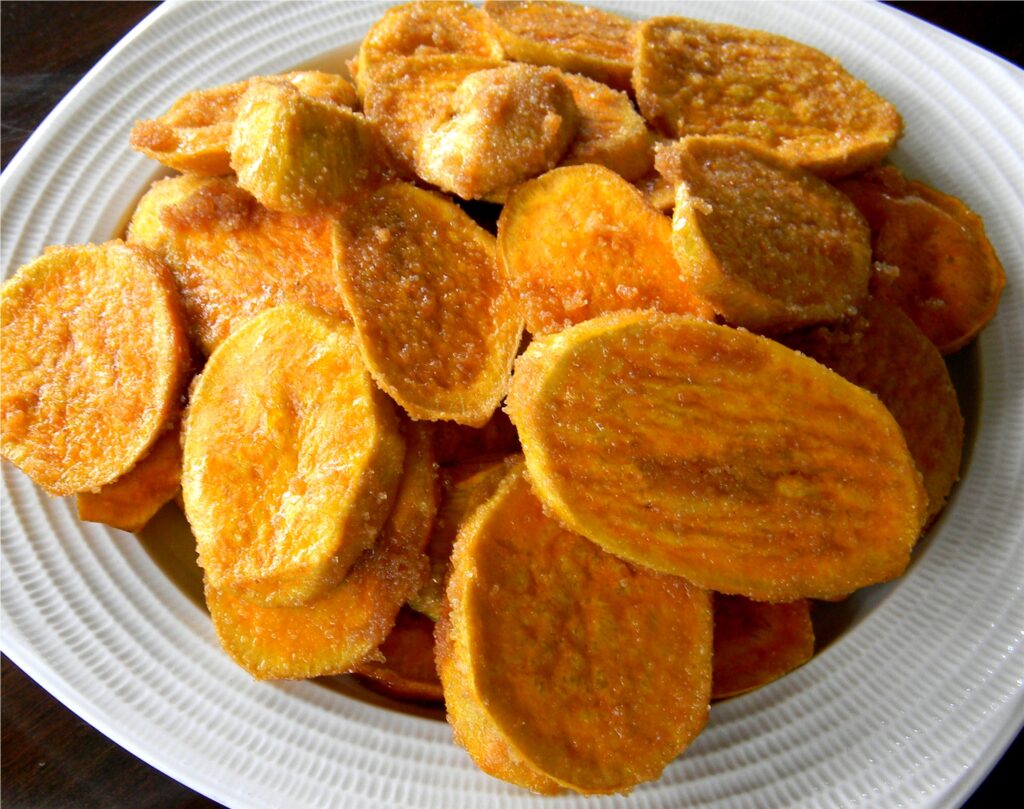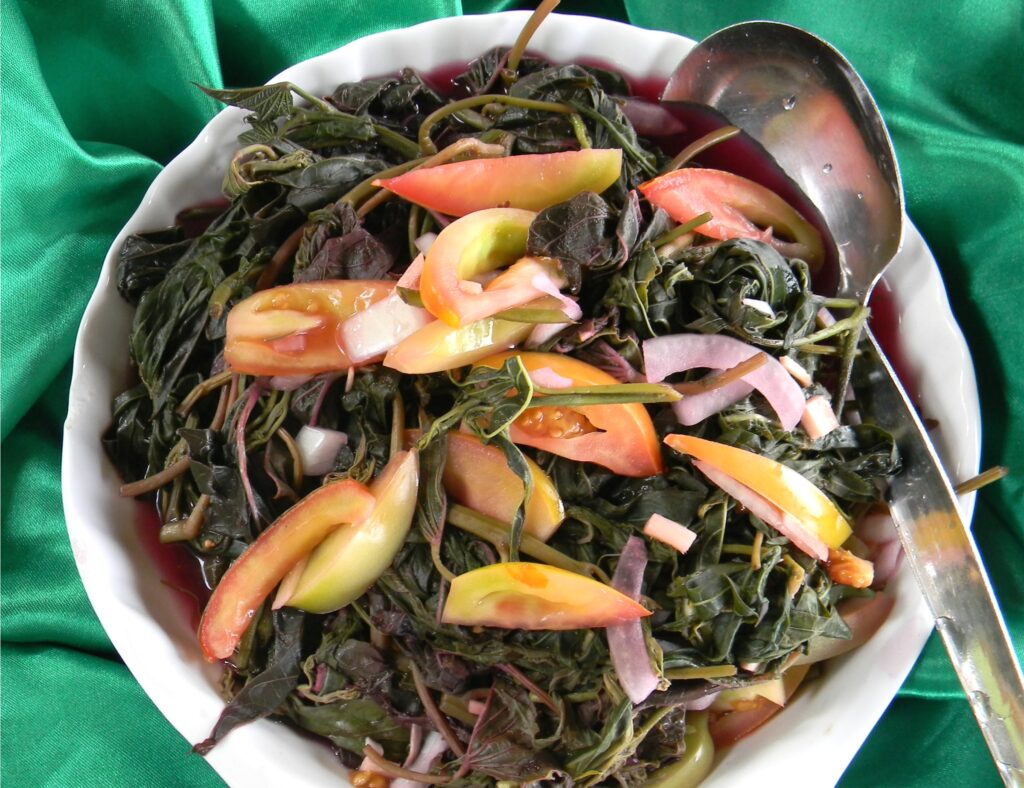Text and Photos by Henrylito D. Tacio
Filipinos are rice-eating people. Their average annual rice consumption of 123 kilograms per person is among the highest in the world. “If we did not have rice, our deepest comfort food, we would probably feel less Filipino,” observed late food epicure Doreen Fernandez.
It’s no wonder rice is considered a political crop. It is almost always used during political rallies. During the election, rice is among those being given to people in order for them to vote for a certain candidate. When there is a rice shortage, some resort to riots.
If the Philippines has a second national flower (waling-waling with sampaguita as its first), why not a second staple food? Nutritionists are suggesting sweet potato as the best alternative to rice. In fact, sweet potato is a staple food source of many indigenous populations in Central and South Americas, Africa, the Caribbean, Hawaiians, and Papua New Guineans.
After all, the Philippines is the sixth-largest sweet potato producer in Asia and the 19th in the world. About 40% of sweet potato production is from Eastern Visayas and Bicol region, according to the Philippine Council for Agriculture, Aquatic and Natural Resources Research and Development (PCAARRD).
The Philippine Statistics Authority listed Central Visayas, Zamboanga Peninsula, Eastern Visayas, Caraga, and Northern Mindanao as the top producing regions in 2019. That year, the volume of sweet potatoes produced in the country was approximately 525.9 thousand metric tons.
Unknown to many, growing sweet potatoes is a profitable venture. In 2018, the production value of the crop was almost P9 billion.

Fried camote 
Talbos ng kamote
“There are farmers who are making millions of pesos selling sweet potato,” Asia Regional Director Samarendu Mohanty of the International Potato Center told Business World. “The problem is when you look at the Philippines, sweet potato production has been declining. It used to be (planted in) 250,000 hectares in 1980. Now, it’s less than 80,000 hectares.”
Something must be done. “There are a lot of technologies. There are organizations with developing technologies available in the Philippines and elsewhere. But the thing is how it will reach farmers?” Mohanty asked. “There are different technologies but farmers don’t have any clue.”
In a techno-forum on sweet potato held in Benguet some years back, experts shared their knowledge on crop’s propagation technology, disease management, and processing and value-addition.
Farmers need to plant clean planting materials (CPMs) if they want a good harvest. “The use of CPM increases yield of quality and disease-free sweet potato,” said Dr. Ines C. Gonzales, chief science research specialist of the Northern Philippines Root Crops Research and Training Center (NPRCRTC).
She suggested that one of the best ways to sustain and maintain quality CPMs is through the seed plot technique. “Farmers need to practice selecting the CPMs from the field, label it, and use it for the next cropping season,” she explained.
By doing this, farmers can save additional expenses from buying new CPMs. Propagating CPMs can also be an excellent business to venture into. An 800-square meters of land would be enough to start with a possibility of a 50% return on investment.
Sweet potato is attacked by several diseases, but Fusarium wilt is a major disease infecting almost all of the sweet potato farms in the Cordilleras. In Nueva Vizcaya, a Fusarium wilt outbreak in 2011 almost wiped out the 495 hectares of sweet potato.
The first step in saving the sweet potato from Fusarium wilt and other diseases is by treating the soil, according to Rhonda M. Oloan and Andres A. Basalong, researchers from the Bureau of Plant Industry (BPI).
“Because of excessive use of chemical farm inputs, the natural microorganisms and nutrients of the soil are depleted and becomes more vulnerable to diseases,” the two BPI experts explained, adding that one way of conditioning and enriching the soil is through the use of Trichoderma (an effective microorganism as a biocontrol agent against diseases) and the practice of crop rotation.
If best practices are being done by farmers, including the use of CPMs, NPRCRTC believes the Fusarium wilt will be mitigated and, thus, quality sweet potatoes will be produced sustainably.
In the early 1990s, NPRCRTC had collected 900 varieties of sweet potato from all over the country. “There used to be so many sweet potato varieties in the country, however, due to diseases and poor crop management, some of them are no longer available,” Dr. Gonzales reported.
As an alternative to rice, NPRCRTC has come up with new varieties according to its purpose (as fries, boiled, or processed) based on the flesh color, texture, and their resistance to pests and diseases.
“Insect pests and diseases, which were difficult to manage, are the limiting factors in sweet potato production,” the research and training center admitted. “However, challenges on insect pests and diseases are being addressed with new technologies on pest management.”
Like rice, sweet potatoes can be prepared in many ways. “With sweet potato as the base commodity, you can develop a lot of products,” said Prof. Basalong. To name a few: camote hopia, camote cookies, camarind (a combination of camote and tamarind), candy, camote bread, camote-guyabano juice, camberry (a combination of camote and strawberry), candy, pan de camote, camote muffin, and camote turon.
“Through these processed products, we are encouraging high consumption of sweet potato especially among the young ones who prefer more processed products and not the plain sweet potato,” Prof. Basalong stressed. “These product innovations will also increase public awareness that will eventually lead to higher consumption of this commodity.”
Although sweet potato is a root crop, the Washington, D.C.-based Center for Science in the Public Interest ranked sweet potato (known in the science world as Ipomoea batatas or locally called camote) “the most nutritious food of all vegetables.”
The North Atlantic Human Nutrition Research Center on Aging considered sweet potato as one of the world’s healthiest foods. For one, it has the highest amounts of vitamin A among the root vegetables category. It is almost fat-free (0.39 grams).
According to the United State Department of Agriculture, for one medium-size sweet potato, you get 2.15 grams of protein, 31.56 grams of net carbs, 3.8 grams of dietary fiber, 28.6 milligrams of calcium, 16.9 milligrams of sodium, 265.2 milligrams of potassium, and 29.51 milligrams of vitamin C.
American nutritionists found that sweet potato has “almost twice the recommended daily allowance of vitamin A, 42 percent of the recommendation for vitamin C, and four times the recommended daily allowance for beta carotene.”
A cup of cooked sweet potato (about 200 grams) is better than broccoli and cabbage in vitamins A and C, iron, and calcium content. Because nutrients are anti-inflammatory, they help reduce the severity of asthma, osteoarthritis, and rheumatoid arthritis.
Having high dietary fiber and low-fat content, sweet potato is suitable for people with diabetes because it helps stabilize blood sugar levels and lowers insulin resistance. Among the root vegetables, camote has the lowest glycemic index. As such, it causes only a small rise in blood glucose levels.
The roots are not the only edible part of camote but also the leaves and tops. Nutritionists claim the leaves and tops contain high amounts of antioxidants, vitamins, minerals, and dietary fiber.
In his monthly column, “Straight from the Farm,” Dr. Rafael D. Guerrero III, wrote: “In a study conducted by Chung-Yen Chen and associates of Tufts University in the United States, it was found that the purple leaves of sweet potato contained six grams of total phenolics and 21.5 grams of beta carotene per 100 grams.
“In another study by nutritionist Richard Baybutt of Kansas State University, it was reported that smokers exposed to benzoapyrene, a cancer-producing chemical in cigarettes, were deficient in vitamin A that contributed to lung inflammation and emphysema. Thus, the consumption of foods high in vitamin like camote is recommended to correct such deficiency.”
Now, some words of warning. “Sweet potato contains measurable amounts of oxalates that can crystallize in body fluids and cause health problems,” writes Arlene May G. Corpus, a therapeutic dietitian at the Manila Adventist Medical Center. “If you have existing and untreated kidney or gallbladder problems, you may want to avoid eating sweet potatoes.”

